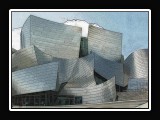
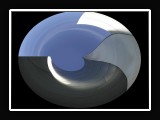
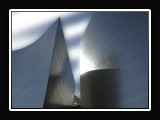
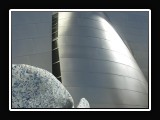
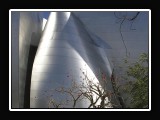
CLICK ANY IMAGE TO ENLARGE AND START SLIDE SHOW
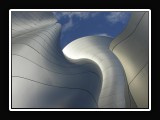
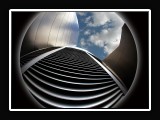

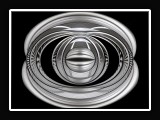
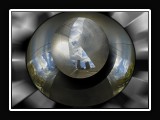
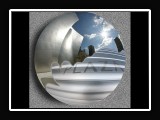
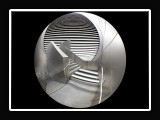
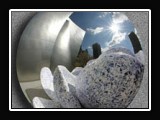
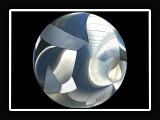
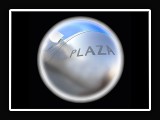
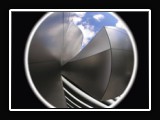
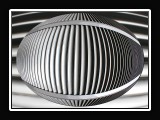
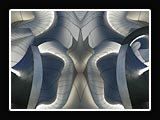
| * | ||
| The
Walt Disney Concert Hall at 111 South Grand Avenue in Downtown Los Angeles,
California is the fourth hall of the Los Angeles Music Center. Bounded
by Hope Street, Grand Avenue, 1st and 2nd Streets, it seats 2,265 people
and serves (among other purposes) as the home of the Los Angeles Philharmonic
orchestra and the Los Angeles Master Chorale. Lillian
Disney made an initial gift in 1987
to build a performance venue as a gift to the people of Los Angeles
and a tribute to Walt Disney's devotion to the arts and to the city.
The Frank Gehry-designed building opened on October 23, 2003. Both the
architecture by Frank Gehry and the acoustics of the concert hall (designed
by Yasuhisa Toyota) were praised in contrast to its predecessor, the
Dorothy Chandler Pavilion. As construction finished in the spring of 2003, the Philharmonic postponed its grand opening until the fall and used the summer to let the orchestra and Master Chorale adjust to the new hall. Performers and critics agree that this extra time taken was well worth it by the time the hall opened to the public.[3] During the summer rehearsals a few hundred VIPs were invited to sit in including donors, board members and journalists. Writing about these rehearsals, L.A. Times music critic, Mark Swed wrote the following account: “ When the orchestra finally got its next [practice] in Disney, it was to rehearse Ravel's lusciously orchestrated ballet, "Daphnis and Chloé" . . . This time, the hall miraculously came to life. Earlier, the orchestra's sound, wonderful as it was, had felt confined to stage. Now a new sonic dimension had been added, and every square inch of air in Disney vibrated merrily. Toyota says that he had never experienced such an acoustical difference between a first and second rehearsal in any of the halls he designed in his native Japan. Salonen could hardly believe his ears. To his amazement, he discovered that there were wrong notes in the printed parts of the Ravel that sit on the players' stands. The orchestra has owned these scores for decades, but in the Chandler no conductor had ever heard the inner details well enough to notice the errors. ” The hall met with lauded approval from nearly all of its listeners, including its performers. In an interview with PBS, Esa-Pekka Salonen, Music Director of the Los Angeles Philharmonic, said, "The sound, of course, was my greatest concern, but now I am totally happy, and so is the orchestra," and later said, "Everyone can now hear what the L.A. Phil is supposed to sound like." This remains to be one of the most successful grand openings of a concert hall in American history. The walls and ceiling of the hall are finished with Douglas-fir while the floor is finished with oak. The Hall's reverberation time is approximately 2.2 seconds unoccupied and 2.0 seconds occupied. The design of the hall included a large concert organ, completed in 2004, which was used in a special concert for the July 2004 National Convention of the American Guild of Organists. The organ had its public debut in a non-subscription recital performed by Frederick Swann on September 30, 2004, and its first public performance with the Philharmonic two days later in a concert featuring Todd Wilson. The organ's facade was designed by architect Frank Gehry in consultation with organ consultant and sound designer Manuel Rosales. Gehry wanted a distinctive, unique design for the organ. He would submit design concepts to Rosales, who would then provide feedback. Many of Gehry's early designs were fanciful, but impractical: Rosales said in an interview with Timothy Mangan of The Orange County Register, "His [Gehry's] earliest input would have created very bizarre musical results in the organ. Just as a taste, some of them would have had the console at the top and pipes upside down. There was another in which the pipes were in layers of arrays like fans. Very fascinating. Couldn't be built. The pipes would have had to be made out of materials that wouldn't work for pipes. We had our moments where we realized we were not going anywhere. As the design became more practical for me, it also became more boring for him." Then, Gehry came up with the curved wooden pipe concept, "like a logjam kind of thing," says Rosales, "turned sideways." This design turned out to be musically viable.[8] The organ was built by the German organ builder, Caspar Glatter-Götz, under the tonal direction and voicing of Manuel Rosales. It has an attached console built into the base of the instrument from which the pipes of the Positive, Great, and Swell manuals are playable by direct mechanical, or "tracker" key action, with the rest playing by electric key action; this console somewhat resembles North-German Baroque organs, and has a closed-circuit television monitor set into the music desk. It is also equipped with a detached, movable console, which can be moved about as easily as a grand piano, and plugged in at any of four positions on the stage, this console has terraced, curved "amphitheatre"-style stop-jambs resembling those of French Romantic organs, and is built with a low profile, with the music desk entirely above the top of the console, for the sake of clear sight lines to the conductor. From the detached console, all ranks play by electric key and stop action. In all, there are 72 stops, 109 ranks, and 6,125 pipes; pipes range in size from a few centimeters/inches to the longest being 9.75m (32 feet) (which has a frequency of 16 hertz). The
organ is a gift to the County of Los Angeles from Toyota Motor Sales,
U.S.A., Inc. (the U.S. sales, marketing, service, and distribution arm
of Toyota Motor Corporation). |